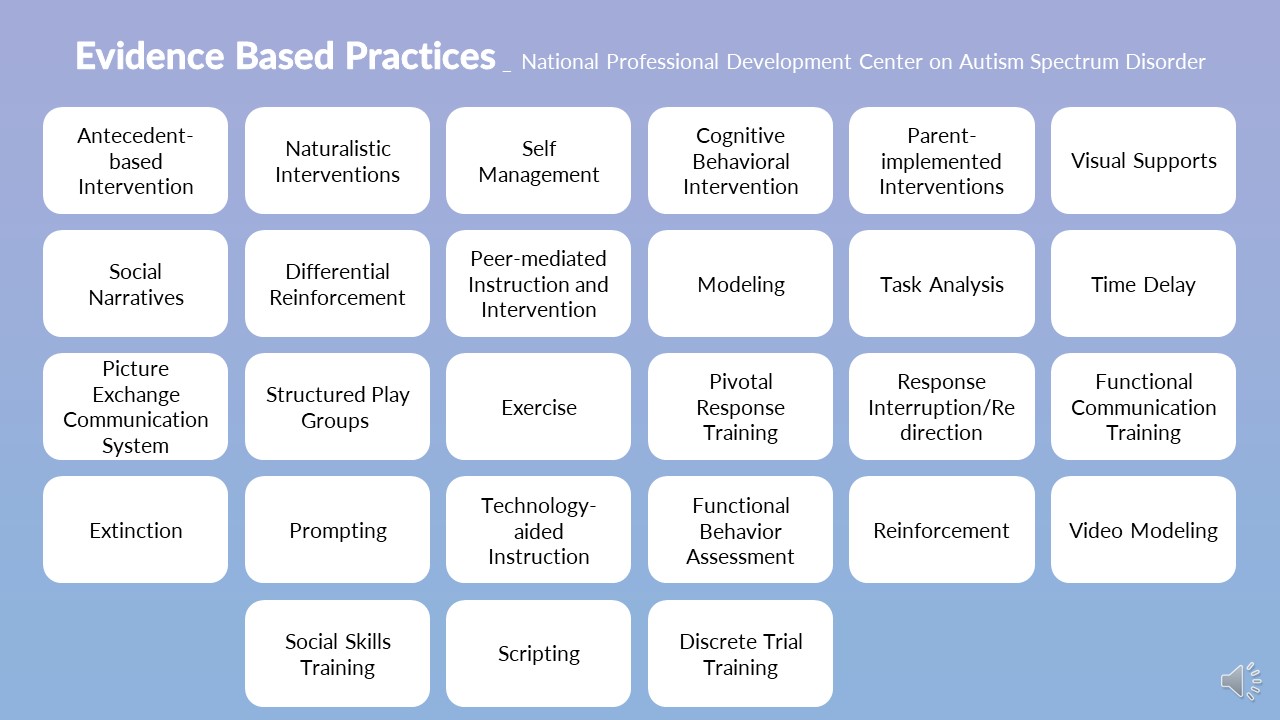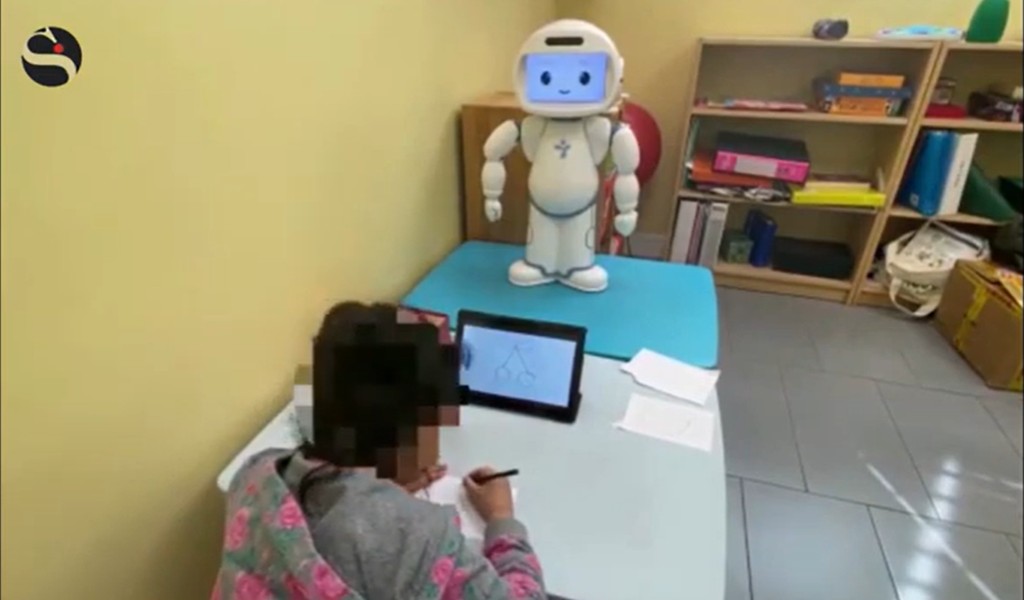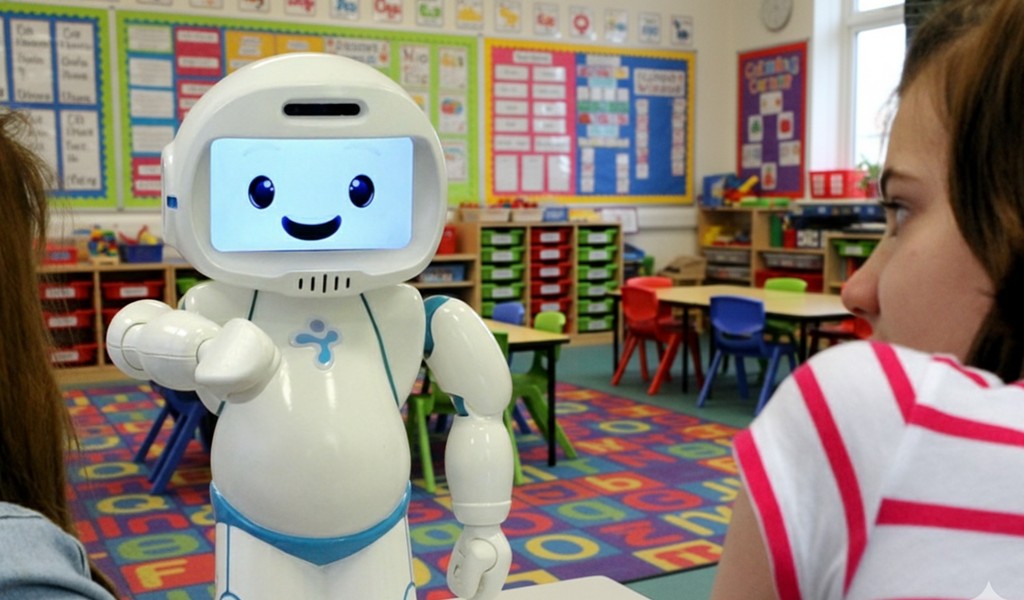Evidence-Based Practices in Autism:
Evidence-based practice refers to teaching or intervention methods that are supported by a substantial level of research, demonstrating their effectiveness in producing positive results for children, youth, or adults with ASD.
The National Clearinghouse on Autism Evidence and Practice (NCAEP) has published its latest report, identifying evidence-based practices (EBPs). This report examines research literature from 1990 to 2017, pinpointing 28 EBPs along with 10 manualized interventions that fulfill the specified criteria.

How does QTrobot assisted intervention incorporates Evidence-Based methods?
QTrobot incorporates 21 of the 28 evidence-based practices for autism intervention and education into it’s curriculum. Each activity benefis from a combinatuion of evidence-based practices based on the educational objective of the activity and the skill area it targets.
Incorporating these practices in the curriculum is critical as it helps esuring a high quality support for students that has a high chance of delivering results while making sure that teh curriculum alligns with the best practices commonly used in the education environment,
What are the evidence-based practices incorporated in QTrobot assisted Intervention?
1 – Technology-aided Instruction and Intervention (TAII)
Technology-aided instruction and intervention leverage technology as a key tool to help learners achieve specific objectives. This approach can involve a variety of devices, including computer monitors, tablets, smartphones, and educational robots tailored to assist children with autism. The use of technology in education has shown a positive impact on teaching and supporting children, significantly enhancing the learning process with measurable results.
One such innovative tool is QTrobot, a social expressive robot specifically designed to optimize social communication and interaction with autistic children. QTrobot’s interactive features engage children in a consistent and non-judgmental manner, making learning enjoyable and reinforcing.
The integration of technology, like QTrobot, into the educational landscape offers a promising avenue for enhancing the learning outcomes of children with autism. Multiple scientific studies have demonstrated the efficacy of QTrobot in improving attention, increasing joint attention, reducing anxiety and stereotypical behaviors, and enhancing emotional literacy in children.
2 – Direct Instruction (DI)
Direct Instruction is a teaching method that benefits from being highly structured and meticulously designed, providing step-by-step teaching interactions. In Direct Instruction, each piece of instruction is presented individually, followed by carefully chosen reinforcement and specific error-correction techniques to ensure mastery. Correct responses are clearly demonstrated, facilitating rapid learning. Each instruction follows a structured setup that includes instruction, error correction, and/or reinforcement before moving on to the next instruction.
QTrobot incorporates Direct Instruction into nearly all of its educational activities to ensure learners receive clear and specific instructions. Each instruction is followed by engaging reinforcement and repetition of the correct answer, or appropriate prompting to prevent trial-and-error learning and reduce frustration if the learner makes a mistake.
3 – Cognitive Behavioral Instructional Strategy (CBIS)
One challenge commonly encountered by individuals with autism is developing awareness of their emotions, understanding what triggers these emotions, and grasping how thoughts, events, and feelings are interconnected. Supporting autistic children in understanding social-emotional behaviors and emotions in both themselves and others has been effective in improving their mental health. Cognitive behavioral interventions are proven methods that help autistic children gain insight into fundamental emotional comprehension, behavioral regulation, and coping strategies, contributing to improved anger management, reduced anxiety, and enhanced social interactions and inclusion.
QTrobot leverages cognitive behavioral interventions in its social-emotional learning activities, assisting children in recognizing emotions, understanding the thoughts or social situations that trigger various emotions, identifying when emotions are overwhelmingly strong, and realizing when reactions to these emotions might lead to negative behaviors. Additionally, QTrobot employs cognitive behavioral strategies to help children develop better coping mechanisms for managing anger, frustration, and anxiety more effectively.
4 – Discrete trial training (DTT)
Discrete Trial Training is typically a one-on-one teaching method designed to impart skills in a deliberate, structured, and sequential manner. DTT is defined by its use of intensive, repeated sessions that have clear start and end points. In DTT, the strategic application of antecedents and consequences plays a crucial role. Each instructional session commences with the instructor giving a precise instruction or presenting a stimulus that prompts a specific behavior. To encourage and reinforce the acquisition of the desired skills or behaviors, practitioners often employ positive feedback and/or tangible rewards. Data collection is an integral part of every DTT session. Additional techniques frequently utilized in DTT include breaking down tasks into smaller, manageable parts (task analysis), providing prompts, introducing a delay before prompting (time delay), and applying reinforcement strategies.
5 – Social Skills Training (SST)
Social Skills Training encompasses any form of adult-led teaching aimed at enhancing social skills. It is commonly delivered in group or one-on-one settings and may extend to guided practice within classroom environments. Additionally, SST can be paired with Peer-Mediated Instruction and Intervention (PMII) or similar strategies that employ peers as models or tutors to facilitate the rehearsal of specific skills.
6 – Task Analysis (TA)
Many tasks, such as brushing teeth, washing hands, or getting dressed, involve multiple steps to complete. Task analysis is a strategy that simplifies teaching these complex or chained behaviors. By breaking down multi-step tasks into smaller, manageable individual steps, task analysis helps learners gain proficiency in each segment, progressively achieving greater independence in executing the entire skill or behavior.
QTrobot utilizes task analysis in various areas of its educational curriculum. For example, it is employed in the self-help and independence curriculum, which focuses on helping learners gain independence in performing daily routine tasks like getting dressed or maintaining personal hygiene. Additionally, the robot uses task analysis for social and communication skills, such as greeting, which involves multiple important components, including verbal interactions and non-verbal communication cues.
7 – Antecedent-Based Interventions (ABI)
Antecedent-Based Interventions (ABI) aim to reduce specific disruptive behaviors through modifications in the environment that alter the circumstances leading to these behaviors. Such behaviors often emerge more frequently under certain environmental conditions that inadvertently reinforce them (Alberto & Troutman, 2008). The objective of ABI is to pinpoint the reinforcing factors behind the disruptive behavior and then adjust the environment or activity in a way that these factors no longer trigger the unwanted behavior.
8 – Functional Communication Training (FCT)
Numerous individuals with autism exhibit behaviors that are inappropriate, maladaptive, and sometimes aggressive towards themselves and others. Frequently, such behaviors arise from communication challenges, resulting in unconventional and undesirable attempts to express specific wants, needs, and interests. Functional Communication Training aims to mitigate these disruptive behaviors by methodically determining the underlying purpose of the behavior and introducing an alternative form of appropriate communication. This approach allows individuals to effectively communicate their needs in a socially acceptable manner.
9 – Modeling (MD)
Modeling is a strategy used to improve a learner’s proficiency in a particular behavior. It involves demonstrating the behavior for the learner to observe or prompting the learner to perform the behavior following an instruction. Modeling can be executed in various forms, including physical gestures, verbal cues like naming or saying a word or sentence, or illustrating how a social interaction should unfold.
QTrobot employs modeling both as a teaching tool and a method of prompting. Specifically, in activities designed to enhance social skills, the robot directly models behaviors, uses video resources and visuals for demonstration, and instructs the robot operator to model behaviors as well. Through these methods, QTrobot facilitates the learning of a wide array of social skills and communication abilities. Additionally, modeling serves as an effective prompt when a learner struggles to follow instructions. By modeling the expected response, the robot helps the learner understand what is required in reaction to specific directives.
10 – Video Modeling (VM)
Video modeling involves creating a video demonstration of a behavior or action, typically performed by a peer, for autistic children to watch and learn from. This technique is effectively used to teach new skills or to correct and improve existing abilities in areas such as social interaction, communication, non-verbal social cues, and physical development.
QTrobot integrates video modeling into its social and emotional activities, allowing learners to watch the demonstrated behaviors and then attempt to replicate them following the robot’s instructions.
11 – Prompting (PP)
Prompting provides learners with assistance to help them develop specific skills or behaviors. This technique, often linked with errorless learning, reduces the likelihood of incorrect responses as new skills are acquired. Prompting is a core strategy used alongside other evidence-based methods, such as time delay and reinforcement, and plays a crucial role in various practices like discrete trial training, pivotal response training, and video modeling.
QTrobot employs a structured, step-by-step prompting approach to ensure children receive the right level of support for the skills they are working on. The robot uses verbal prompts, visual prompts, and modeling to guide learners in responding to questions and following instructions.
12 – Reinforcement (R+)
Reinforcement is used to promote target skills and enhance preferred behaviors. It is a core element that supports other evidence-based strategies, such as prompting and pivotal response training. Reinforcement establishes the link between a learner’s action and the subsequent outcome. For this relationship to be considered reinforcing, the outcome must increase the likelihood of the learner repeating the skill or behavior.
Implementing appropriate reinforcement is critical as it not only enhances children’s engagement and motivation but also helps them understand which behaviors are desired or which answers are correct, thereby facilitating learning and skill development.
QTrobot incorporates reinforcement in a scheduled manner, optimizing the intensity and nature of reinforcement based on the level of success the child achieves. For instance, when a child answers questions independently, the robot provides stronger reinforcement than when the child answers correctly with prompting. Additionally, QTrobot ensures that each instance of student success is reinforced.
Finally, QTrobot utilizes social and naturalistic reinforcements such as smiling, displaying happy gestures, and giving positive verbal comments to celebrate a child’s success. Using social reinforcement is highly effective in the long term as it helps the child enjoy social interactions and positive feedback, rather than relying on food-based or sensory stimuli reinforcements.
13 – Visual Support (VS)
Visual supports act as tangible cues that aid learners in grasping concepts or following a task or instruction more effectively. For autistic children, visual supports offer various benefits. Given that many individuals on the autism spectrum are visual learners, integrating visual aids with verbal explanations can significantly boost their comprehension. Visual supports can clarify social concepts and task specifics, prove invaluable in communicating with learners who have limited verbal skills by enhancing their understanding of spoken instructions, and are particularly effective in breaking down multi-step tasks, enabling learners to independently follow the steps outlined visually.
QTrobot employs visual supports in diverse ways, tailoring their use to the specific activity, the learner’s communicative capabilities, and the complexity of the task at hand. It leverages visual aids to elucidate social interactions, thereby improving understanding and facilitating learning within the realm of social skills.
Additionally, QTrobot combines visual supports with social narratives, visually representing the social concepts the narratives describe. Furthermore, in developing language and cognitive abilities, QTrobot pairs its prompts with straightforward visual instructions, making it easier for learners to follow along.
14 – Social Narrative (SN)
social narratives are a versatile tool in supporting autistic children’s social and emotional learning, providing them with a clearer roadmap for navigating the complexities of social interaction. They provide descriptions designed to convey specific information about a social situation, including the expected behaviors and the perspectives of others involved in the situation. Social narratives help clarify expectations, enhance social understanding and improve social-emotional skills.
QTrobot incorporates social narratives into its social and emotional learning activities to improve learners’ understanding of specific social situations. It offers detailed information about when a behavior is expected, the appropriate way to exhibit it, the reasons behind it, and the effects of displaying versus not displaying these behaviors on both the individual and others. After establishing the context of the social situation and outlining the do’s and don’ts, QTrobot engages learners in interactive activities. These activities are designed to practice applying the steps outlined in the social narrative, allowing learners to internalize and implement the behaviors in real-life scenarios.
15 – Self Management (SM)
Self-management is a technique that empowers learners to monitor their own behaviors, distinguish between positive and negative actions, reflect on their choices, and reward themselves for successfully implementing a behavior or emotion regulation strategy.
QTrobot’s emotional literacy program incorporates self-management techniques, helping learners develop an understanding of their emotions. This enables them to recognize their feelings and identify the sources of those emotions. Once learners understand their emotions, the robot introduces concepts such as recognizing when emotions are too strong or negative, helping them become aware of situations where their emotions might lead to inappropriate actions and negative consequences. Finally, the robot teaches techniques for managing strong or negative emotions, guiding learners to handle challenging situations more effectively.
16 – Parent Implemented Interventions (PII)
Children with ASD often encounter challenges with daily routines and activities within their home settings, leading parents to seek effective strategies they can use to support their children. It’s important for practitioners to offer parent-implemented interventions (PII) to equip parents with the training and guidance needed to apply evidence-based practices (EBPs) with their children during these everyday moments. While parents are at the forefront of implementing PII, practitioners serve as essential supporters, offering coaching, encouragement, and information.
17 – Peer Mediated Instruction and Intervention (PMII)
Various terms that describe Peer-Mediated Instruction and Intervention (PMII) are: Peer Modeling, Peer Initiation Training, Direct Training for the Target Student and Peer, Peer Networks, and Peer Supports. PMII tackles social challenges by educating peers on initiating and responding to the social interactions of individuals with ASD. Grounded in the principles of behaviorism and social learning theory, PMII methodically instructs peers without disabilities on how to involve learners with ASD in constructive and significant social engagements.
19 – Scripting (SC)
A common challenge associated with ASD is trouble with social communication, with some individuals also facing deficits in either expressive or receptive language, hindering their ability to engage with others. Nevertheless, many individuals with ASD exhibit a strength in responding to visual cues and structured environments.
Implementing scripts as an intervention leverages these strengths, offering clear, suitable examples of language and/or social behavior in an organized manner. This strategy aids individuals with ASD in participating in communicative exchanges with others effectively.
20 – Exercise (ECS)
Exercise typically denotes the physical activities undertaken to enhance physical fitness levels. Incorporating regular physical activity into the daily routine of individuals with ASD is crucial for boosting their overall physical health. Beyond enhancing physical fitness, exercise serves as an effective intervention for individuals with ASD to promote positive behaviors like increased academic focus, more time spent on tasks, accurate responses, and completion of tasks. Additionally, exercise can help reduce undesirable behaviors, including aggression, self-harm, stereotypical movements, and distractions from tasks.




